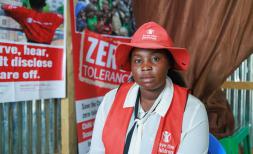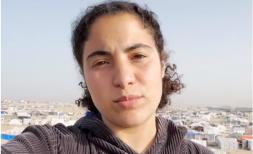Countdown to the Global Refugee Forum: A Spotlight on Ethiopia

Fardowsa, 12, smiles outside her family's home in the Somali Region. Save the Children
In December 2023, leaders from across the globe will gather for the 2nd Global Refugee Forum, it is a landmark opportunity to deliver decisive action for refugee children. Earlier this year, Save the Children published a new report – The Price of Hope - detailing the progress made on refugee education since 2019. This blog series is counting down to the start of the GRF with a deeper dive into some of the top refugee hosting countries, this week we are taking a closer look at Ethiopia.
“My favourite thing to do in my free time is studying, I am interested to go abroad so I enjoy learning English.” - Fardowsa*, 12-years-old, in seventh grade at a primary school which is supported by Save the Children. Since 2019, there have been five failed rainy seasons across the Horn of Africa leaving up to 20 million people in Ethiopia experiencing food insecurity. Girls are often bearing the brunt of the consequences of this hardship, facing increased rates of gender-based violence and being forced to drop out of school or into child marriage.
WHAT IS THE SITUATION IN ETHIOPIA?
Ethiopia is the third largest refugee-hosting country in Africa, home to 867,799 refugees, of this 432,316 are school-age refugee children – most of whom live in 24 refugee camps and primarily come from Eritrea, South Sudan, Sudan, and Somalia. Ethiopia maintains an ‘open door’ policy to refugees and asylum-seekers. The conflict in Sudan that erupted in April 2023 forced over 1 million people to seek safety elsewhere, this year 17,801 refugee families arrived from Sudan to Ethiopia because of the conflict. Ethiopia has had a long-standing history welcoming refugees from Somalia and the recent conflict in Somalia’s Sool region has produced close to 100,000 refugees hoping to escape violence.
The dawn of conflict in Northern Ethiopia in November 2020 resulted in the relocation of thousands of Eritrean refugees to Addis Ababa, growing urban refugee numbers to over 71,000 in April 2022, and forced some 34,000 refugees to abandon Berhale camp in Afar. Long-term challenges continue to have worsening effects across the country, but especially on the refugee population, the latest statistical abstract indicates that refugee access to education has been negatively impacted by both the Covid pandemic and the conflict in Tigray.,
BARRIERS TO EDUCATION FOR REFUGEE CHILDREN
In principle refugees are included in the national education system, as demonstrated by the current Education Sector Development Programme, which builds on Ethiopia’s commitment as a signatory of the Djibouti Declaration on Refugee Education to include refugees in the national education system.
Despite Ethiopia’s admirable efforts, several barriers to refugees’ inclusion in the national system persist. Enrolment rates are significantly below the national average of 95%, with rates as low as 24% for refugee girls in middle school. The main challenge is the lack of safe and inclusive learning environments. At early childhood currently most provision is actually by national and international NGOs, with little state provision. From primary onwards where schools do exist they are usually inaccessible to those with disabilities, and may lack basic facilities.
Refugees also face significant language barriers as there is limited support for mother-tongue education or acquisition of local languages. Girls face additional socio-cultural barriers and risks of gender-based violence at or on the way to and from schools, leading to the much lower enrolment rates of refugee girls, particularly at higher levels of education. Currently there is limited availability of accelerated education for those who have missed significant periods of education, although ESDP VI does plan for an expansion of accelerated education.
A HIGH RISK OF DEBT DISTRESS THREATENING EDUCATION
About 20 percent of the government of Ethiopia’s budget is covered through domestic and external borrowing, resulting in Ethiopia’s public debt, at the end of September 2022, reaching 50.1% of GDP. Ethiopia’s external debt presents a greater risk. External debt servicing was 1.8% of the GDP in 2020, and its ratio to export reached 22% in 2022, standing above the recommended IMF ceiling of 15 percent, positioning Ethiopia at high risk of debt distress. Greater budget allocation to debt servicing is only expected to increase with a ‘widening fiscal deficit caused by increased expenditure for defence and emergency response/humanitarian assistance for populations affected by conflict, drought, and other shocks.‘ External debt servicing is tightening the fiscal space for education spending with only 5.6% of the GDP spent on education. Ethiopia’s challenging economic situation proves more detrimental to the lives of refugees, with refugees tending to have lower incomes than host community households with every two out of three refugees living in poverty.
These challenges are denying refugee children access to the life-saving and protective impacts of a quality education in a safe school environment. The international community must mobilise at the upcoming GRF to deliver bold action that ensures an education for every last refugee child, including the large refugee populations in countries like Ethiopia.
FIVE THINGS SAVE THE CHILDREN WANTS TO SEE AT THE 2023 GLOBAL REFUGEE FORUM
- Make the promise of the Global Compact on Refugees a reality. The Global Compact provide blueprints to ensure that refugees, as well as host communities, get the support they require to meet their education needs. We must not waste this opportunity.
- Put refugee children at the heart of the Global Refugee Forum. They are experts on the challenges they face, their safe and meaningful participation must be prioritised.
- Prioritise matched pledges to advance responsibility sharing. Educating refugee children is a global public good and must be a shared global responsibility.
- Pledges must be meaningful, accountable and actionable. It is imperative that all pledges include timelines for completion and measurable targets and indicators so that progress can be properly tracked.
- Focus on the money needed to ensure all refugees have access to quality education. Opening education to all refugee children and including them in national education systems can be achieved at an estimated annual cost of US$4.85 billion globally.







